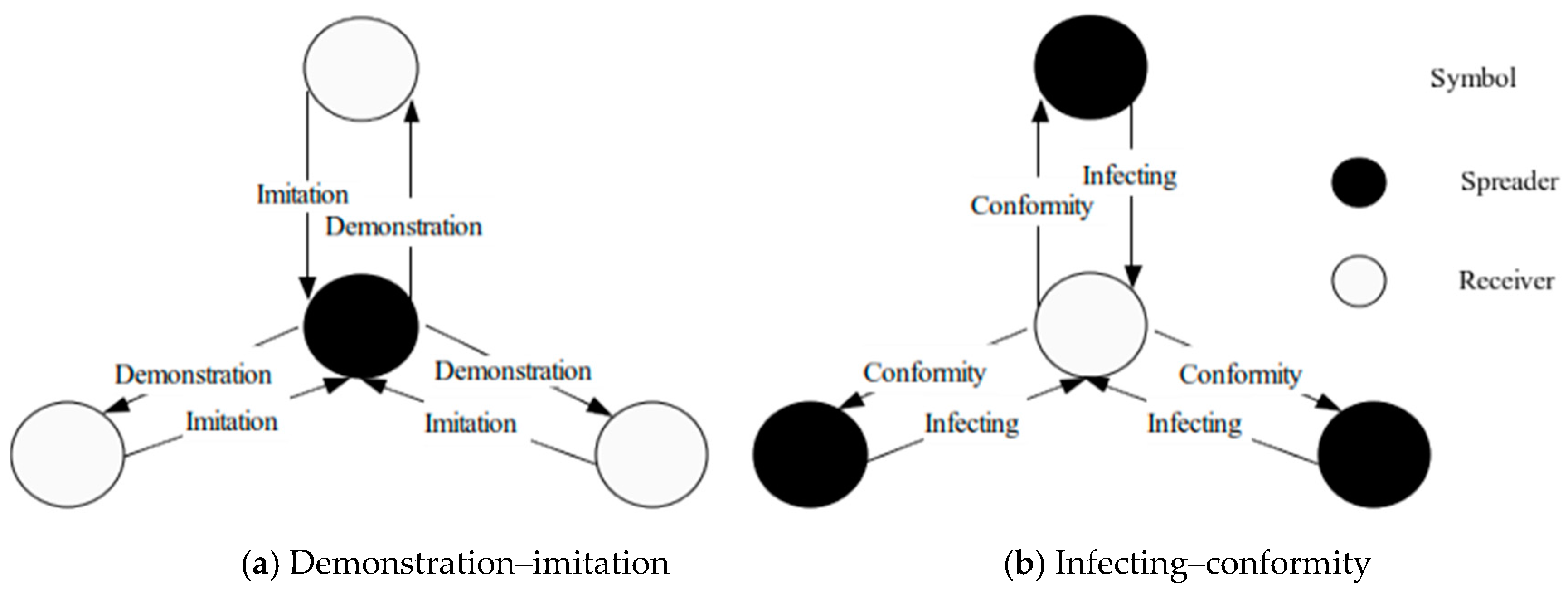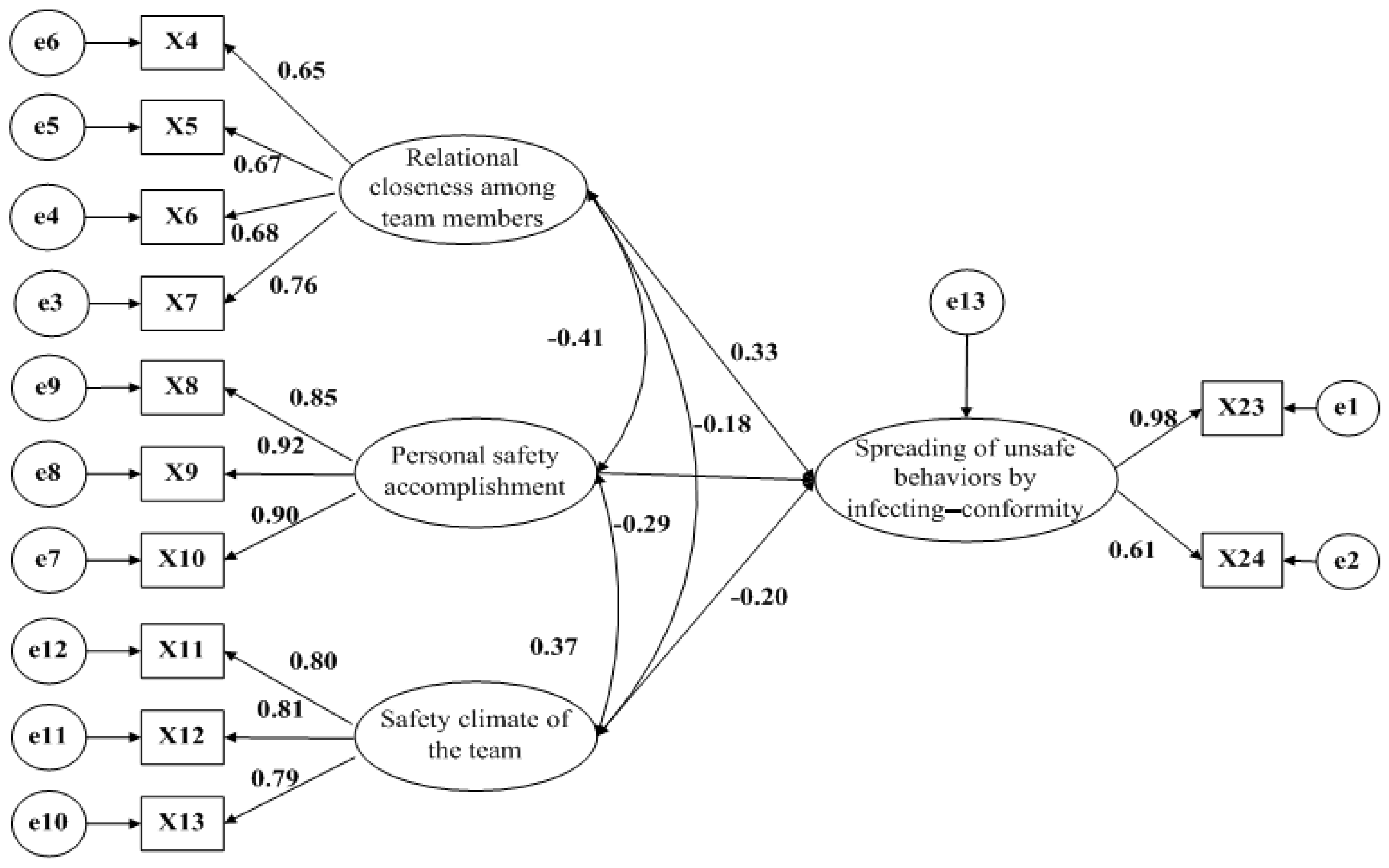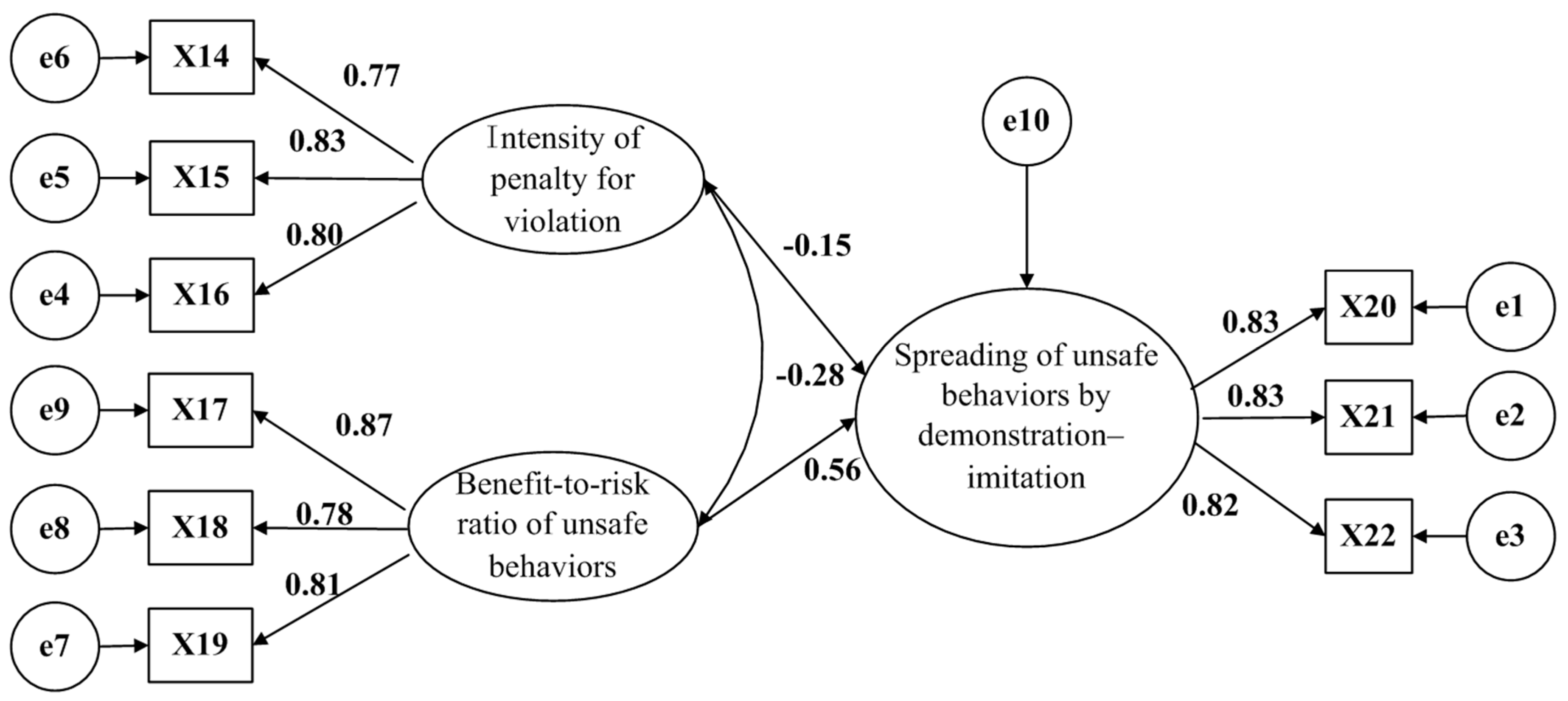Structural Equation Model Analysis of Factors in the Spread of Unsafe Behavior among Construction Workers
Abstract
:1. Introduction
2. Mechanism of Spreading Unsafe Behaviors among Construction Workers and Research Hypothesis
2.1. Mechanism of Spreading Behavior
2.2. Research Hypothesis
3. Research Design and Methods
4. Model Verification
5. Result Analysis and Discussion
6. Conclusions
- (1)
- The spread of unsafe behaviors of construction workers refers to the duplication, evolution, and propagation of unsafe behaviors through worker interactions, and the spreading mechanisms include demonstration–imitation and infecting–conformity.
- (2)
- The benefit-to-risk ratios of unsafe behaviors are an important factor taken into account by workers while they adopt these behaviors; the higher the benefit-to-risk ratio, the more easily an unsafe behavior can be spread.
- (3)
- Improving personal safety accomplishment is a fundamental approach in preventing the spread of unsafe behaviors; however, owing to factors such as culture, concept, etc., it is difficult to improve the personal safety accomplishment of construction workers in China within a short period of time.
- (4)
- The influence of important figures and the intensity of penalties for safety violations are correlated significantly with the spread of unsafe behaviors. Focusing on the demonstration effect of team leaders and technical specialists, controlling typical unsafe behaviors and enhancing the intensity of penalties for safety violations would create a ‘warning effect’ and significantly prohibit the spread of unsafe behaviors through demonstration–imitation.
- (5)
- Relational closeness and safety climates are correlated significantly with the spread of unsafe behaviors through infecting–conformity. A good safety climate would be favorable for prohibiting the spread of unsafe behaviors through infecting–conformity, and the relational closeness of team members is a catalyst in spreading unsafe behaviors through infecting–conformity.
Acknowledgments
Author Contributions
Conflicts of Interest
References
- Ye, G.; Chen, M.-L.; Wang, H.-X. Study on modified TPB model for construction workers unsafe behavioral intention. China Saf. Sci. J. 2015, 25, 145–151. [Google Scholar]
- Han, Y.; Mei, Q.; Liu, S.-X.; Sun, Y. Formation of construction workers’ habitual unsafe behaviors and factors influencing it. China Saf. Sci. J. 2015, 25, 29–35. [Google Scholar]
- Aksorn, T.; Hadikusumo, B.H.W. Critical success factors influencing safety program performance in Thai construction projects. Saf. Sci. 2008, 46, 709–727. [Google Scholar] [CrossRef]
- Chen, Q.; Jin, R. Safety4Site commitment to enhance jobsite safety management and performance. J. Constr. Eng. Manag. 2012, 138, 509–519. [Google Scholar] [CrossRef]
- Chen, Q.; Jin, R. Multilevel safety culture and climate survey for assessing new safety program. J. Constr. Eng. Manag. 2013, 139, 805–817. [Google Scholar] [CrossRef]
- Chen, Q.; Jin, R. A comparison of subgroup construction workers’ perceptions of a safety program. Saf. Sci. 2015, 74, 15–26. [Google Scholar] [CrossRef]
- Seo, H.C.; Lee, Y.S.; Kim, J.J.; Jee, N.Y. Analyzing safety behaviors of temporary construction workers using structural equation modeling. Saf. Sci. 2015, 77, 160–168. [Google Scholar] [CrossRef]
- Fang, D.; Jiang, Z.; Zhang, M.; Wang, H. An experimental method to study the effect of fatigue on construction workers’ safety performance. Saf. Sci. 2015, 73, 80–91. [Google Scholar] [CrossRef]
- Li, H.; Lu, M.; Hsu, S.C.; Gray, M.; Huang, T. Proactive behavior-based safety management for construction safety improvement. Saf. Sci. 2015, 75, 107–117. [Google Scholar] [CrossRef]
- McGuigan, N.; Makinson, J.; Whiten, A. From over-imitation to super-copying: Adults imitate causally irrelevant aspects of tool use with higher fidelity than young children. Br. J. Psychol. 2011, 102, 1–18. [Google Scholar] [CrossRef] [PubMed]
- Caspers, S.; Zilles, K.; Laird, A.R.; Eickhoff, S.B. ALE meta-analysis of action observation and imitation in the human brain. Neuroimage 2010, 50, 1148–1167. [Google Scholar] [CrossRef] [PubMed]
- Chen, W.; Liu, L. Critical review of psychological studies on imitation. Adv. Psychol. Sci. 2013, 21, 1833–1843. [Google Scholar] [CrossRef]
- Han, Y.; Mei, Q.; Liu, S.; Ying, S. Investigation and analysis of imitation and learning of unsafe behaviors for construction workers. J. Saf. Sci. Technol. 2015, 11, 182–188. [Google Scholar]
- Han, Y.; Mei, Q.; Zhou, D.; Liu, S. Spreading features of construction workers’ unsafe behavior: Form group closeness perspective. J. Saf. Sci. Technol. 2016, 12, 185–192. [Google Scholar]





| Code | Launch Time | Name of Investigation | Interviewees |
|---|---|---|---|
| Investigation 1 | 2014.7–2015.6 | Investigation into the basic conditions of unsafe behaviors of construction workers | 411 |
| Investigation 2 | 2014.9–2015.6 | Investigation into the group structural characteristics of construction workers | 125 |
| Investigation 3 | 2014.12–2015.8 | Investigation into the income states and satisfaction of construction workers | 83 |
| Investigation 4 | 2015.3–2015.8 | Investigation into the occupational safety and health conditions of painters in the construction industry | 78 |
| Investigation 5 | 2015.3–2015.8 | Investigation into the occupational safety and health conditions of electric welders in the construction industry | 106 |
| Investigation 6 | 2015.6–2015.8 | Investigation into habitual unsafe behaviors of construction workers | 26 |
| Contents | Factor 1 | Factor 2 | Factor 3 | Factor 4 | Factor 5 | Factor 6 |
|---|---|---|---|---|---|---|
| X1 Authority and influence of the team leader | 0.787 | |||||
| X2 Professional skills and influence of technical specialists | 0.840 | |||||
| X3 Safety behaviors and influence of safety model | 0.803 | |||||
| X4 Task similarity among workers | 0.668 | |||||
| X5 Skill similarity among workers | 0.760 | |||||
| X6 Cultural consistency among workers | 0.825 | |||||
| X7 Personal similarity among workers | 0.738 | |||||
| X8 Safety knowledge level of workers | 0.901 | |||||
| X9 Safety skill level of workers | 0.887 | |||||
| X10 Safety consciousness level of workers | 0.887 | |||||
| X11 Compliance with safety rules among team members | 0.800 | |||||
| X12 Safety activity involvement of team members | 0.876 | |||||
| X13 Frequency of safety accidents within the team | 0.786 | |||||
| X14 Intensity of economic punishment of individuals | 0.819 | |||||
| X15 Intensity of labor punishment on individuals | 0.790 | |||||
| X16 Intensity of system punishment on individuals | 0.831 | |||||
| X17 Time revenue of unsafe behaviors | 0.867 | |||||
| X18 Labor revenue of unsafe behaviors | 0.871 | |||||
| X19 Process experience of unsafe behaviors | 0.842 | |||||
| Cronbach’s α | 0.921 | 0.785 | 0.857 | 0.823 | 0.841 | 0.807 |
| Variance interpretation rate % | 13.917 | 12.987 | 12.739 | 12.117 | 12.077 | 11.474 |
| Accumulated variance interpretation rate % | 13.917 | 26.904 | 39.643 | 51.760 | 63.837 | 75.312 |
| KMO value | 0.816 | |||||
| Bartlett test chi-square value | 2384.336 | |||||
| p value | 0.000 | |||||
| Item | Factor 1 | Factor 2 |
|---|---|---|
| X20 Observation of workers and spreading of unsafe behaviors | 0.876 | |
| X21 Imagination of workers and spreading of unsafe behaviors | 0.865 | |
| X22 Communication between workers and spreading of unsafe behaviors | 0.877 | |
| X23 Group atmosphere and spreading of unsafe behaviors | 0.847 | |
| X24 Group pressure and spreading of unsafe behaviors | 0.906 | |
| Cronbach’s α | 0.862 | 0.745 |
| Variance interpretation rate % | 47.165 | 32.271 |
| Cumulative Variance interpretation rate % | 47.165 | 79.436 |
| KMO value | 0.739 | |
| Bartlett test chi-square value | 492.659 | |
| p value | 0.000 | |
© 2018 by the authors. Licensee MDPI, Basel, Switzerland. This article is an open access article distributed under the terms and conditions of the Creative Commons Attribution (CC BY) license (http://creativecommons.org/licenses/by/4.0/).
Share and Cite
Jiang, H.; Wang, J.; Han, Y.; Yin, H. Structural Equation Model Analysis of Factors in the Spread of Unsafe Behavior among Construction Workers. Information 2018, 9, 39. https://doi.org/10.3390/info9020039
Jiang H, Wang J, Han Y, Yin H. Structural Equation Model Analysis of Factors in the Spread of Unsafe Behavior among Construction Workers. Information. 2018; 9(2):39. https://doi.org/10.3390/info9020039
Chicago/Turabian StyleJiang, Hui, Jianping Wang, Yu Han, and Huiguang Yin. 2018. "Structural Equation Model Analysis of Factors in the Spread of Unsafe Behavior among Construction Workers" Information 9, no. 2: 39. https://doi.org/10.3390/info9020039
APA StyleJiang, H., Wang, J., Han, Y., & Yin, H. (2018). Structural Equation Model Analysis of Factors in the Spread of Unsafe Behavior among Construction Workers. Information, 9(2), 39. https://doi.org/10.3390/info9020039




